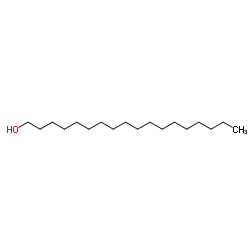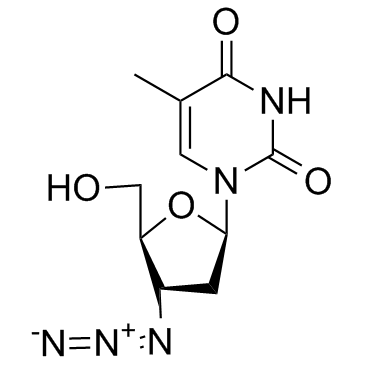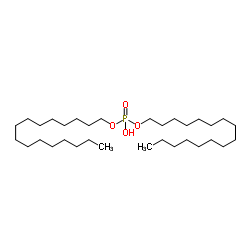Dioctadecyl phosphite

Dioctadecyl phosphite structure
|
Common Name | Dioctadecyl phosphite | ||
|---|---|---|---|---|
| CAS Number | 19047-85-9 | Molecular Weight | 586.95300 | |
| Density | N/A | Boiling Point | N/A | |
| Molecular Formula | C36H75O3P | Melting Point | 55-61ºC | |
| MSDS | N/A | Flash Point | 185ºC | |
| Name | dioctadecoxy(oxo)phosphanium |
|---|---|
| Synonym | More Synonyms |
| Melting Point | 55-61ºC |
|---|---|
| Molecular Formula | C36H75O3P |
| Molecular Weight | 586.95300 |
| Flash Point | 185ºC |
| Exact Mass | 586.54500 |
| PSA | 59.00000 |
| LogP | 13.93230 |
| InChIKey | OKXAFOJPRGDZPB-UHFFFAOYSA-N |
| SMILES | CCCCCCCCCCCCCCCCCCO[P+](=O)OCCCCCCCCCCCCCCCCCC |
Synonym: Section 2 - COMPOSITION, INFORMATION ON INGREDIENTS
Risk Phrases: None Listed. Section 3 - HAZARDS IDENTIFICATION EMERGENCY OVERVIEW
The toxicological properties of this material have not been fully investigated.Moisture sensitive. Potential Health Effects Eye: May cause eye irritation. Skin: May cause skin irritation. Ingestion: The toxicological properties of this substance have not been fully investigated. Inhalation: May cause respiratory tract irritation. Chronic: Not available. Section 4 - FIRST AID MEASURES Eyes: Flush eyes with plenty of water for at least 15 minutes, occasionally lifting the upper and lower eyelids. Get medical aid. Skin: Flush skin with plenty of water for at least 15 minutes while removing contaminated clothing and shoes. Get medical aid if irritation develops or persists. Ingestion: Get medical aid. Wash mouth out with water. Inhalation: Remove from exposure and move to fresh air immediately. If not breathing, give artificial respiration. If breathing is difficult, give oxygen. Get medical aid if cough or other symptoms appear. Notes to Physician: Section 5 - FIRE FIGHTING MEASURES General Information: As in any fire, wear a self-contained breathing apparatus in pressure-demand, MSHA/NIOSH (approved or equivalent), and full protective gear. Extinguishing Media: Use water spray, dry chemical, carbon dioxide, or chemical foam. Section 6 - ACCIDENTAL RELEASE MEASURES General Information: Use proper personal protective equipment as indicated in Section 8. Spills/Leaks: Vacuum or sweep up material and place into a suitable disposal container. Section 7 - HANDLING and STORAGE Handling: Avoid breathing dust, vapor, mist, or gas. Avoid contact with skin and eyes. Storage: Store in a cool, dry place. Store in a tightly closed container. Section 8 - EXPOSURE CONTROLS, PERSONAL PROTECTION Engineering Controls: Facilities storing or utilizing this material should be equipped with an eyewash facility and a safety shower. Exposure Limits CAS# 19047-85-9: Personal Protective Equipment Eyes: Wear chemical splash goggles. Skin: Wear appropriate protective gloves to prevent skin exposure. Clothing: Wear a chemical apron. Respirators: A NIOSH/MSHA approved air purifying dust or mist respirator or European Standard EN 149. Section 9 - PHYSICAL AND CHEMICAL PROPERTIES Physical State: Solid Color: white Odor: Mild odor pH: Not available. Vapor Pressure: 5 mm Hg @ 185 deg C Viscosity: Not available. Boiling Point: Not available. Freezing/Melting Point: 57 - 59 deg C Autoignition Temperature: Not available. Flash Point: 185 deg C ( 365.00 deg F) Explosion Limits, lower: Not available. Explosion Limits, upper: Not available. Decomposition Temperature: Solubility in water: insoluble Specific Gravity/Density: Molecular Formula: C36H75O3P Molecular Weight: 586.96 Section 10 - STABILITY AND REACTIVITY Chemical Stability: Stable under normal temperatures and pressures. Conditions to Avoid: Exposure to moist air or water. Incompatibilities with Other Materials: Acids, oxidizing agents, strong bases, moisture. Hazardous Decomposition Products: Phosphine, carbon monoxide, oxides of phosphorus, carbon dioxide. Hazardous Polymerization: Has not been reported. Section 11 - TOXICOLOGICAL INFORMATION RTECS#: CAS# 19047-85-9 unlisted. LD50/LC50: Not available. Carcinogenicity: Di-n-octadecyl phosphite, 95% C18, (GC) - Not listed by ACGIH, IARC, or NTP. Section 12 - ECOLOGICAL INFORMATION Section 13 - DISPOSAL CONSIDERATIONS Dispose of in a manner consistent with federal, state, and local regulations. Section 14 - TRANSPORT INFORMATION IATA Not regulated as a hazardous material. IMO Not regulated as a hazardous material. RID/ADR Not regulated as a hazardous material. Section 15 - REGULATORY INFORMATION European/International Regulations European Labeling in Accordance with EC Directives Hazard Symbols: Not available. Risk Phrases: Safety Phrases: S 24/25 Avoid contact with skin and eyes. WGK (Water Danger/Protection) CAS# 19047-85-9: No information available. Canada CAS# 19047-85-9 is listed on Canada's NDSL List. CAS# 19047-85-9 is not listed on Canada's Ingredient Disclosure List. US FEDERAL TSCA CAS# 19047-85-9 is listed on the TSCA inventory. SECTION 16 - ADDITIONAL INFORMATION N/A |
| Safety Phrases | S24/25 |
|---|---|
| HS Code | 2920901900 |
|
~77% 
Dioctadecyl pho... CAS#:19047-85-9 |
| Literature: Mallinckrodt LLC; Rogers, Thomas E. Patent: US2013/66086 A1, 2013 ; Location in patent: Paragraph 0127; 0128; 0129; ; |
|
~%
Detail
|
| Literature: BRINE-ADD FLUIDS LTD. Patent: US2011/46408 A1, 2011 ; Location in patent: Page/Page column 8 ; |
|
~% 
Dioctadecyl pho... CAS#:19047-85-9 |
| Literature: Xiao, Qiang; Sun, Jing; Ju, Yong; Zhao, Yu-Fen; Cui, Yu-Xin Tetrahedron Letters, 2002 , vol. 43, # 30 p. 5281 - 5283 |
| HS Code | 2920901900 |
|---|---|
| Summary | 2920901900 VAT:17.0% Tax rebate rate:9.0% Supervision conditions:none MFN tariff:6.5% General tariff:30.0% |
| Distearyl phosphite |
| di-n-octadecyl phosphite |
| Phosphorous acid,dioctadecyl ester |
| Dioctadecyl phosphite |
| dioctadecyl hydrogen phosphonate |
| EINECS 242-784-9 |
| Dioctadecyl phosphonate |
| Distearylphosphit |
| Phosphonic acid,dioctadecyl ester |






 CAS#:2197-63-9
CAS#:2197-63-9 CAS#:3037-89-6
CAS#:3037-89-6 CAS#:29690-03-7
CAS#:29690-03-7